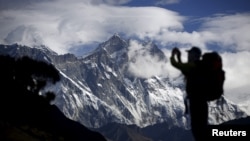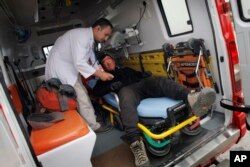Mount Everest has claimed four lives in as many days, while two other climbers remained missing Tuesday on the crowded, treacherous mountain.
An Indian climber died while being helped down from the summit, days after a Dutch man, an Australian woman and a Sherpa died near the peak. Two other Indian climbers are missing.
Dozens of other climbers have developed frostbite or become sick near the summit in recent days, including the Australian woman's husband, who was taken by helicopter to a hospital in Kathmandu on Monday.
Relatively good conditions so far this year have brought large numbers of hopefuls to the mountain the Nepalese call Sagarmāthā, which loosely translates to "forehead in the sky."
Since Everest was first conquered by New Zealander Edmund Hillary and Nepali Sherpa Tenzing Norgay in 1953, more than 4,000 climbers have reached the 8,850-meter peak. Nearly 400 of those climbers have reached the summit since May 11.
Nepal's government issued permits this year to 289 climbers, each of whom paid $11,000 to the government, plus another $25,000 to $50,000 to an expedition company that provides guides, equipment and, often, bottled oxygen to use at high altitudes. The climbers are accompanied on the mountain by around 400 local Sherpa guides.
Among them was the first combat amputee to climb the mountain, U.S. Marine Corps veteran Thomas Charles Linville, 30, who lost his leg to an IED in Iraq in 2011.
American Melissa Arnot on Monday became the first American woman to successfully summit and descend Everest without using extra oxygen.
Previous disasters
Mountaineering is a major revenue earner for impoverished Nepal. Officials had hoped this year's climbing season would bring success and restore confidence in the route, after deadly disasters canceled climbing the previous two years.
Last year, an earthquake and avalanche on Mount Everest buried at least 19 people at a base camp. In 2014, 16 guides were killed while crossing a difficult part of the mountains. Both disasters halted climbing on Mount Everest for two years and raised concerns about the stability of mountain trails.
But the head of the nonprofit Nepal Mountaineering Association, Ang Tshering Sherpa, said this year's tragedies were avoidable.
"This was a man-made disaster that may have been minimalized with the better management of the teams," he said. "The last two disasters on Everest were caused by nature, but not this one."
Tshering said the competition between expedition organizers has become so fierce that they are dropping their prices, which can lead to compromises in equipment, oxygen tanks and experienced guides to help get climbers to the top.











